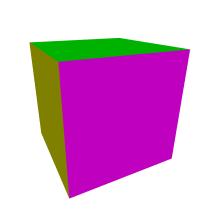4Dspace wrote:Now that I stopped laughing at our misunderstanding... actually, my understanding of you. The fault lies entirely with meMy apologies! So, the "4Der eyes" is the projection of 4d->3d? Granted, it is still not delivered to us in its full glory, because, after that, it has to be projected 3d->2d. Now I understand what you meant!
Thank you for all our efforts and all your time
OK, now that I calmed down a bit, I have to say it's also partly my fault for taking your words at face value, instead of giving you the benefit of the doubt and trying to figure out what you were trying to say. So I also have to apologize for my rude reactions.

Now I see where you're coming from... you're trying to do 4D->2D projection directly (which jives with your previous statement that you want to see 4D as a 3Der instead of a 4Der -- now it all makes sense to me). Initially I brushed that off as an unhelpful approach -- probably because I'm too biased by my past experience, because when I initially studied 4D, there was a point where I had an epiphany that just as we 3Ders see 3D as projections into 2D, so also a native 4Der would see 4D as projections into 3D, and therefore to visualize 4D "as a 4Der would", all it takes is for us to know what is the projected 3D image in the 4Der's eye (which in theory is no problem for us, because we're so facile with 3D constructs), and from thence infer the 4th dimension as the 4Der would do. Ever since then I've always approached the subject from this angle of 4D->3D projections, and I've always considered the 3D->2D part merely as a clutch so that it can be displayed on the 2D screen.
Your approach is different, in that you're trying to tackle the 4D directly as a 4D->2D projection. I had my doubts about the usefulness of such an approach, but after some reconsideration, I have to say that perhaps the idea is not as untenable as I had preconceived. Remember the Flatland question that you posed earlier, about the part where the Square can see the entirety of his 2D world laid bare before his eyes from a 3D vantage point? I had passed it off as an error on Edwin Abbott's part, since the Square doesn't have 3D eyes, and therefore can't possibly see what a native 3D being can see. However, I missed the fact that just because the Square can't see 2D the way we see 2D, doesn't necessarily mean that Abbott's statement about the entire 2D world being laid bare before the Square's eyes is untrue. For, if you think about it carefully, now that the Square has been displaced into 3D, his eye therefore resides at some 3D coordinates outside his 2D world. That means that now, every point of the 2D world has an unobstructed path to his eyes, so that he must be able to see all of it. Of course, due to his retina being merely 1D, he would not see this grand view the same way we 3D beings see it; instead (assuming that all of that light falls on his retina) he sees it all collapsed into a single line, with every slice of the 2D world superimposed upon each other in the tiny space of his 1D retina.
Similarly, if we, as a 3D being, were to be somehow displaced into the 4th dimension, then in theory every point of the 3D world would have an unobstructed path to our eyes, and therefore all of it must become visible to us simultaneously. Of course, our eyes having only a 2D retina, we can't see this grand view as a native 4Der can (a full 3D array of pixels, if you think of her retina as a 3D array of light-sensitive cells); instead, we see everything superimposed upon each other into a single 2D image. Since the image is 2D, every plane therefore must be either clockwise or anticlockwise, from our point of view, so what you said totally makes sense after all.
(Of course, the possibility of this "direct" 4D->2D vision is based on the assumption that the light from outside the 3D hyperplane our eyes lie in will somehow be correctly focused onto the retina -- but it's a bit pointless to argue over such technicalities. For our purposes here, we might as well just consider the eye as a single point in 4D space, which captures whatever light passes through that point. The important thiing is that this is a direct 4D->2D projection.)
What is most curious, of course, is that under such a direct 4D->2D projection, what we'd see is in fact exactly the same as the images I've been rendering: everything is transparent... or appears to be so, not because they're actually transparent, but because light from multiple points in 4D space is falling upon the same cells in our 2D retina. So although I have been thinking in terms of the 3D image that forms in the 4Der's retina when she looks at some 4D construct, the 2D images themselves can also be interpreted as a direct 4D->2D projection -- and the transparency is even automatic! And the math bears this out: a 4D->3D projection from some viewpoint V can be represented as a 5x5 homogenous matrix, and a subsequent 3D->2D projection can be represented as a 4x4 homogenous matrix, but the 4x4 matrix can be extended to 5x5 (by added another row/column with a 1 at the lower right corner), and the two multiplied together to yield a "direct" 4D->2D projection matrix that corresponds to some modified 4D viewpoint V' (the modification is usually just a change in orientation of the 4D camera, without changing its location or what it's pointing at, with the effect that the projected image is rotated in some way).





